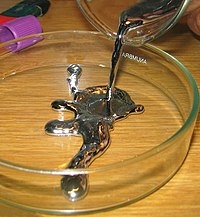
Photo from wikipedia
The concentrations, potential sources, and compositional profile of PBDEs in the surface water and sediment of Nahoon Estuary, East London, South Africa, were investigated with solid-phase extraction and ultra-sonication, respectively,… Click to show full abstract
The concentrations, potential sources, and compositional profile of PBDEs in the surface water and sediment of Nahoon Estuary, East London, South Africa, were investigated with solid-phase extraction and ultra-sonication, respectively, followed by gas-chromatography-electron capture detection. The seasonal range of the contaminants’ concentrations in water and sediment samples in spring season were ∑PBDE 329 ± 48.3 ng/L (25.32–785 ng/L) and ∑PBDE 4.19 ± 0.35 ng/g dw (1.91–6.57 ng/g), but ∑PBDE 62.1 ± 1.50 ng/L (30.1–110 ng/L) and ∑PBDE 65.4 ± 15.9 ng/g dw (1.98–235 ng/g) in summer, respectively. NH1 (first sampling point) was the most contaminated site with PBDE in the Estuary. The potential source of pollution is attributed to the stormwater runoff from a creek emptying directly into the Estuary. This study’s dominant PBDE congener is BDE-17, ranging from below detection limit to 247 ng/L and 0.14–32.1 ng/g in water and sediment samples, respectively. Most detected at all the sites were BDE-17, 47, 66, and 100. Most BDE-153 and 183 are found in sediment in agreement with the fact that higher brominated congeners of PBDE adsorb to solid materials. There was no correlation between the congeners and organic carbon and organic matter. However, the human health risk assessment conducted revealed that the PBDE concentration detected in the estuary poses a low eco-toxicological risk. Nevertheless, constant monitoring should be ensured to see that the river remains safe for the users, as it serves as a form of recreation to the public and a catchment to some neighbourhoods.
Journal Title: Molecules
Year Published: 2022
Link to full text (if available)
Share on Social Media: Sign Up to like & get
recommendations!